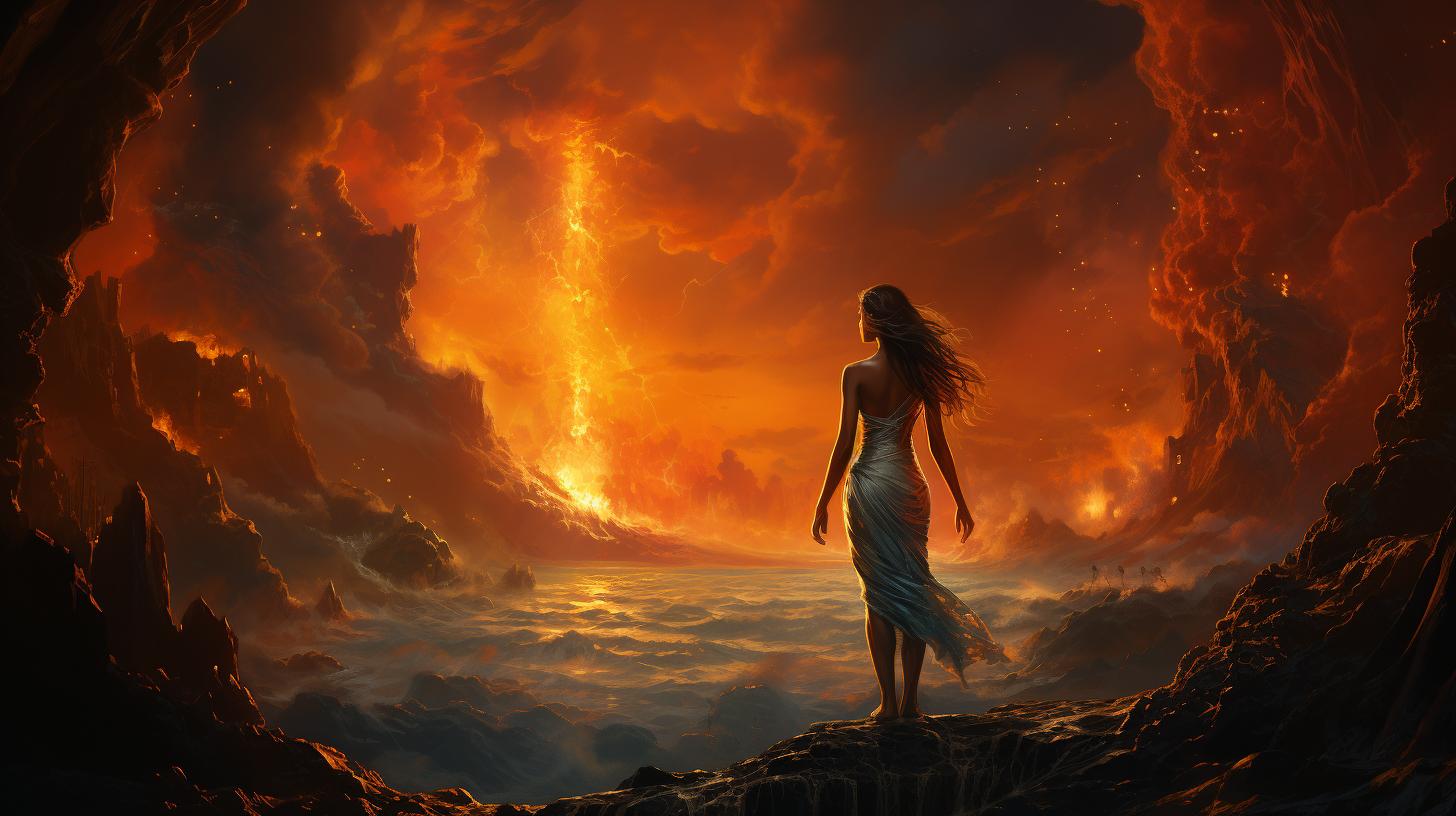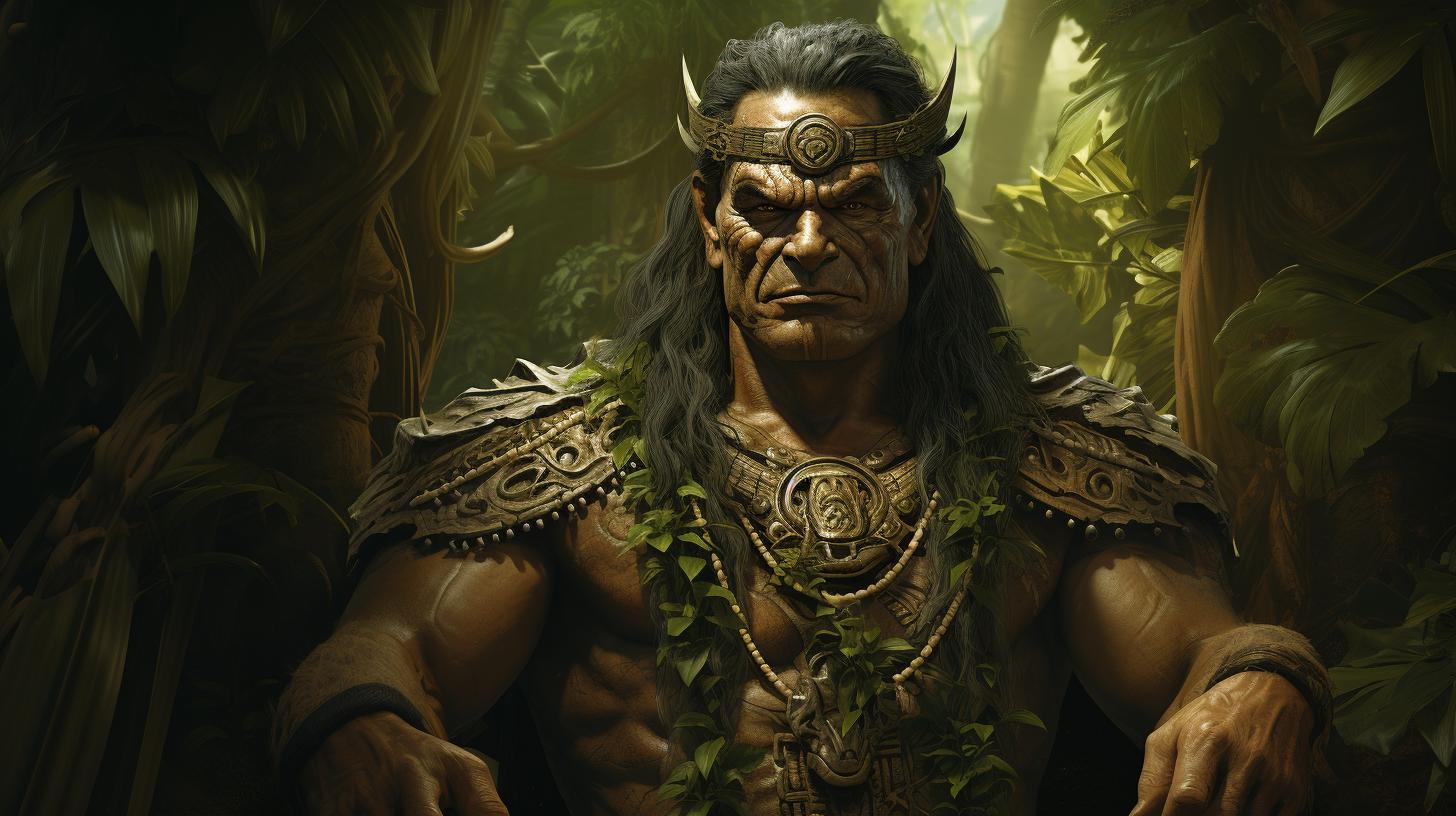The Hawaiian Goddess Pele: Unveiling the Fire and Passion of Hawaii’s Iconic Deity


The Hawaiian goddess Pele is a significant figure in Hawaiian culture and mythology. Known as the goddess of fire and volcanoes, Pele is believed to reside in the Halemaumau Crater within Hawaii Volcanoes National Park.
With her passionate and temperamental nature, Pele has shaped the volcanic landscape of Hawaii through her volcanic eruptions. Her presence is felt by many, and she is considered a sacred and powerful deity in native Hawaiian beliefs.
This article explores Pele’s origins, legends, volcanic influence, and her enduring impact on Hawaiian culture and identity.
The Significance of Pele in Hawaiian Culture
Pele, the Hawaiian goddess of fire and volcanoes, holds immense importance in Hawaiian culture. This section delves into the various aspects that make Pele a significant figure in the traditions and beliefs of the Hawaiian people.
The Hawaiian Goddess Pele: An Introduction
Pele, also known as Pelehonuamea, is revered as the most visible among the ancient deities of Hawaii. As the goddess of fire and volcanoes, she has left an indelible mark on the Hawaiian islands through her fiery presence and transformative powers.
The Legends and Myths Surrounding Pele
The mythology and legends surrounding Pele are rich and varied, contributing to her mystique and significance. Tales of her exile from Tahiti and her journey to Hawaii, along with stories of her love affairs, infidelities, and fierce battles with her sister, Namakaokahai, highlight Pele’s complex and captivating character.
Exploring the Hawaiian Deity’s Origins and Journey
Uncover the origins of Pele and trace her journey to the Hawaiian islands. Legends speak of her tumultuous voyage, where she encountered challenges, created volcanoes and craters along her path, and ultimately settled on Hawaii, where she established her home.
Pele as the Goddess of Fire and Volcanoes
Pele’s dominion over fire and volcanoes is central to her identity. Discover the depth of her power as she controls volcanic eruptions, shapes the landscape, and adds new land to Hawaii’s southeastern coast through her molten lava rivers.
The Connection Between Pele and the Hawaiian Islands
Explore the profound link between Pele and the Hawaiian islands. Learn how her presence and influence have shaped not only the geology but also the cultural and spiritual identity of the Hawaiian people, establishing her as a figure of immense reverence.
Pele’s Role in Hawaiian Volcanism
Pele, the Hawaiian goddess of fire and volcanoes, holds a significant role in shaping the volcanic landscape of Hawaii. Her fiery nature and powerful influence have long been intertwined with the geological activities of the islands.
The Volcanic Landscape Shaped by Pele
Throughout history, Pele’s fiery eruptions have crafted the breathtaking volcanic landscape of Hawaii. From majestic mountains to expansive lava fields, her handiwork is evident in the unique terrain of the islands.
The constant transformation and creation of new land by Pele’s volcanic activity contribute to the ever-evolving geography of Hawaii.
Understanding Volcanic Activity in Hawaii
Hawaii possesses a rich volcanic history, largely influenced by Pele’s presence. The unique geology of the islands, characterized by shield volcanoes and lava flows, showcases the ongoing volcanic activity that has shaped the archipelago.
Understanding the mechanisms and patterns of this volcanic activity helps scientists and researchers monitor the impact of Pele’s power on the islands.
The Volcanic Eruptions Linked to Pele’s Desires
Pele’s eruptions are often attributed to her desires and emotions. According to Hawaiian mythology, these volcanic outbursts are manifestations of her passion, anger, or longing. The volcanic eruptions act as a creative force, shaping the land while reflecting Pele’s ever-changing moods and desires.
Exploring Pele’s Home: Halemaumau Crater
Halemaumau Crater, located within Hawaii Volcanoes National Park, is considered Pele’s home and the epicenter of her volcanic power. Visitors can witness the visible evidence of Pele’s presence in the form of lava lakes, steam vents, and sulfur gases emanating from the crater.
Exploring this sacred site provides a deeper understanding of Pele’s connection to the land and her profound role in Hawaiian volcanism.
Pele’s Temperament and Relationships
The personality and relationships of Pele, the Hawaiian goddess, are as fiery and captivating as her volcanic domain.
Pele’s Character: Passion and Temperament
Pele is known for her passionate and tempestuous nature, which is reflected in her actions and interactions. She is often described as fierce, unpredictable, and quick to anger. Her fiery temperament resonates with the volcanic landscape she inhabits, embodying the elemental forces of fire and destruction.
Pele’s Conflict with Her Sister Namakaokahai
Pele’s most infamous feud is with her sister Namakaokahai, the goddess of the sea. The clash between the two deities represents the eternal struggle between fire and water. Legends recount their fierce battles, where Pele’s volcanic eruptions clashed with Namakaokahai’s powerful waves, shaping the landscape and leaving behind a tale of sibling rivalry and natural phenomena.
Pele’s Infamous Love Affairs and Intrigues
Pele is also renowned for her numerous love affairs, infidelities, and intriguing relationships. Legends tell of her amorous encounters with mortal men and her passionate entanglements with other gods and deities.
These affairs often resulted in dramatic conflicts, adding to the complexity of Pele’s character and the richness of Hawaiian mythology.
The Epic Battle of Pele and Hi’iaka
One of the most dramatic stories in Pele’s mythology is her conflict with her sister Hi’iakaikapoliopele. Hi’iaka embarks on a journey to retrieve Pele’s love interest, only to face obstacles and tests along the way.
The epic battle between Pele and Hi’iaka shows the consequences of Pele’s fiery temper and the profound impact it has on her relationships and those around her.
Pele’s Presence and Legacy in Hawaii Today
Experiencing Pele’s Spiritual Presence
When visiting the volcanic landscapes of Hawaii, one can feel the powerful spiritual presence of Pele.
The energy emanating from the active volcanoes and the sacred sites associated with the goddess create a unique and awe-inspiring atmosphere. Many locals and visitors alike have reported sensing Pele’s spiritual energy, which is said to be both mesmerizing and humbling.
Pele’s Cultural Significance and Worship Today
Pele continues to hold immense cultural significance in Hawaiian traditions and beliefs. She is revered as a guardian of the land and a symbol of strength and resilience. Devotees and followers of the goddess engage in various forms of worship, including offering chants, hula dances, and rituals at sacred sites associated with Pele.
Her influence can also be observed in the practices of traditional healing and spiritual ceremonies.
Pele: Inspirations in Art, Literature, and Music
Pele’s iconic status has inspired countless artists, writers, and musicians to celebrate her in their creations. Through paintings, sculptures, poems, novels, and songs, Pele’s fiery and tempestuous nature has been captured and immortalized.
Her presence in the arts serves as a testament to the enduring fascination and admiration that Pele evokes, as artists strive to channel her passion and power into their work.
Preserving and Protecting Pele’s Sacred Sites
Recognizing the cultural and spiritual importance of Pele’s sacred sites, efforts have been made to preserve and protect these areas.
Local communities, alongside governmental and non-profit organizations, work together to ensure that these sites are respected and safeguarded for future generations. Strict guidelines and protocols are in place to ensure responsible visitation and minimize any potential negative impacts on the natural and cultural integrity of these sites.
- Efforts to preserve sacred sites associated with Pele
- Collaboration between local communities and organizations
- Guidelines for responsible visitation to minimize impact
- Respecting the cultural and spiritual significance of Pele’s sites
In conclusion, Pele’s presence and legacy continue to thrive in modern-day Hawaii.
Her spiritual energy can be felt, her cultural significance endures, and her inspiration permeates the arts. As efforts are made to preserve and protect her sacred sites, Pele’s influence on Hawaiian identity remains strong, ensuring that her fiery spirit will continue to ignite the hearts and minds of those who encounter her.
Exploring Pele’s Influence on the Geology of Hawaii
Exploring Pele’s influence on the geology of Hawaii unveils the significant role she plays in shaping the Hawaiian islands. From her geological contributions to the formation and transformation of the landscape, to the powerful forces behind her volcanic actions, Pele’s impact is undeniable.
Pele’s Geological Contributions to the Hawaiian Islands
Pele’s presence on the Hawaiian islands extends beyond mythology. Through her volcanic activity, she has contributed to the creation of new land. Over the years, Pele has added more than 70 acres of new land to the southeast coast of the Big Island, emitting rivers of lava down the mountainside.
These volcanic eruptions have played a vital role in the formation and expansion of the Hawaiian islands.
Formation and Transformation: Pele’s Impact on the Landscape
The active volcanoes under Pele’s influence have shaped the unique terrain of Hawaii. Lava flows have carved out valleys, created expansive lava fields, and formed impressive volcanic features such as cinder cones and maar craters.
The constant geological activity has resulted in the ever-changing landscape, showcasing Pele’s ongoing impact on the islands.
The Powerful Forces Behind Pele’s Volcanic Actions
Pele’s volcanic actions are fueled by the powerful forces within the Earth’s core. The geological processes involve the movement of tectonic plates, which create the conditions for magma to rise to the surface.
As the magma reaches the surface, it erupts, releasing lava, gases, and volcanic ash. These explosive events are a manifestation of Pele’s power and her role as the goddess of fire and volcanoes.
As visitors explore the geological wonders of Hawaii, they can witness firsthand the evidence of Pele’s influence. The majestic volcanic landscapes, the raw power of lava flows, and the ever-changing nature of the islands all showcase the geological legacy left by the Hawaiian goddess Pele.
The Influence of Pele on Native Hawaiians
The goddess Pele holds immense importance in Native Hawaiian beliefs and practices. Her presence is deeply intertwined with the spiritual and cultural identity of the Hawaiian people, shaping their worldview and values.
Pele’s Importance in Native Hawaiian Beliefs and Practices
Pele is revered as a powerful deity who embodies the essence of fire, creation, and transformation. Native Hawaiians believe that she has the ability to give and take life, symbolizing the cycle of death and rebirth.
She is seen as both a creator and destroyer, embodying the dualistic nature of existence.
Native Hawaiians have deep respect and reverence for Pele, considering her not only as a goddess but also as a relative and caretaker of the land.
They believe that she commands the volcanic forces and is responsible for the constant creation and reshaping of the Hawaiian islands.
Pele as a Source of Strength and Identity
Pele’s influence extends beyond the realm of mythology and spirituality. She serves as a source of strength and inspiration for the Hawaiian people, empowering them to overcome challenges and adversity. Many Hawaiians draw on Pele’s fiery determination and passion as a reminder to persevere and stay connected to their cultural roots.
Native Hawaiians see themselves as descendants of Pele, acknowledging their ancestral ties to the land and the goddess herself. Pele’s story and legacy serve as a reminder of their unique heritage and the deep connections between humans, nature, and spirituality.
Cultural Protocols and Respect for Pele’s Sacredness
Out of respect for Pele and the sacredness of her presence, Native Hawaiians follow specific cultural protocols when interacting with volcanic areas associated with her. These protocols include seeking permission before entering her domain, offering prayers or chants, and refraining from taking anything as souvenirs.
Native Hawaiians believe that failing to honor Pele’s sacredness can result in misfortune or angering the goddess. This respect for Pele’s power and presence underscores the profound cultural and spiritual connection between the Hawaiian people and the land they inhabit.
7. Myths and Misconceptions About Pele
There are several misunderstandings surrounding the Hawaiian goddess Pele that have been perpetuated over time. By debunking these myths and addressing popular misconceptions, we can gain a deeper understanding of Pele’s true nature and significance.
Debunking Common Misunderstandings About Pele
- Pele is not merely a symbol of destruction: While she is associated with volcanic activity, Pele represents much more than just destruction. She embodies creation, transformation, and the cycle of life.
- Pele is not a vengeful deity: Contrary to popular belief, Pele is not a vengeful goddess who arbitrarily brings harm.
Her eruptions are seen as expressions of her desires and emotions, rather than acts of retribution.
- Pele is not a malevolent force: Despite her fiery nature, Pele is not an evil entity.
She is a complex deity with both light and dark aspects, reflecting the dualities of life.
Separating Fact from Fiction: Addressing Popular Myths
- Myth: Pele is a fictional character created for mythology purposes only.
- Fact: Pele is a deeply revered figure in Hawaiian culture, with historical and cultural evidence supporting her existence and impact.
- Myth: Pele constantly causes destruction and chaos in Hawaii.
- Fact: Pele’s volcanic activity is a natural process that has shaped the Hawaiian Islands over millions of years.
While eruptions can cause temporary disruptions, they are also responsible for the creation of new land.
- Myth: Pele can be controlled or manipulated through human rituals.
- Fact: Pele is a powerful deity who cannot be controlled or influenced by human rituals.
Respect and reverence for her are important, but attempting to manipulate her is not seen as appropriate in Hawaiian culture.
Understanding Pele Beyond Stereotypes and Simplifications
It is crucial to move beyond simplistic stereotypes when it comes to understanding Pele. She is not a one-dimensional character but a complex goddess with multifaceted aspects. Pele represents the powerful forces of nature, the fiery passions of the human spirit, and the enduring connection between land and culture in Hawaii.
Exploring the various layers of Pele’s mythology helps us appreciate the richness and depth of Hawaiian culture.
Experiencing Pele’s Power: Visiting the Hawaiian Volcanoes
Immerse yourself in the awe-inspiring power of Pele by exploring the magnificent volcanic landscape of Hawaii. With its iconic volcanoes and breathtaking scenery, Hawaii Volcanoes National Park offers an unparalleled opportunity to witness Pele’s volcanic activity firsthand.
Exploring Hawaii Volcanoes National Park
Begin your journey by venturing into Hawaii Volcanoes National Park, a UNESCO World Heritage Site that showcases the volcanic wonders of the islands. Discover the diverse ecosystems, unique geological formations, and rich cultural significance of this remarkable park.
Stroll along the Crater Rim Drive and marvel at the vast expanse of the Kilauea Caldera, where Pele’s presence is most prominent. Explore the Thurston Lava Tube, formed by ancient lava flows, and get a glimpse into the underground world sculpted by Pele’s fiery touch.
Witnessing Pele’s Volcanic Activity
Experience the raw power of Pele by witnessing her ongoing volcanic activity. Hike along the Chain of Craters Road to witness the dramatic coastline, where lava meets the ocean in a spectacle of steam and explosions.
Visit the Jaggar Museum and Observation Deck, where you can peer into the vast Halemaumau Crater and possibly witness Pele’s fiery displays. As the sun sets, the glowing lava illuminates the night sky, creating a mesmerizing and unforgettable sight.
Safety Tips and Considerations for Volcano Visitors
While visiting the Hawaiian volcanoes, it is crucial to prioritize safety and respect for the natural environment. Follow these tips to ensure a memorable and secure experience:
- Stay on designated trails and respect all closures for your safety.
Volcanic landscapes can be unpredictable, and venturing into restricted areas can be dangerous.
- Check the latest updates on volcanic activity and adhere to any warnings or instructions from park rangers. Volcanic eruptions can create hazardous conditions.
- Be prepared for changing weather conditions and dress accordingly.
Wear sturdy footwear and bring essentials such as water, sunscreen, and a hat.
- Respect the cultural significance of the land and do not remove any rocks, plants, or artifacts. Leave only footprints and take only photographs.
By observing these guidelines, you can safely experience the awe-inspiring power of Pele and gain a deeper appreciation for the dynamic forces that shape the Hawaiian Islands.
Pele’s Influence on Hawaiian Culture and Identity
Pele’s Role in Hawaiian Art, Dance, and Music
Pele’s presence permeates through various forms of artistic expression in Hawaiian culture. Artists, musicians, and dancers draw inspiration from Pele’s fiery spirit and incorporate her into their work. Paintings, sculptures, and traditional hula dances often depict Pele and her volcanic power.
The rhythmic beats of Hawaiian music reflect the fiery intensity associated with Pele, and her stories are often featured in traditional chants and songs.
Pele’s Impact on Hawaiian Language and Literature
The influence of Pele extends to the Hawaiian language and literature.
Her myths and legends have been passed down through generations in the form of oral storytelling and written works. Hawaiian literature often pays homage to Pele, celebrating her power, strength, and tumultuous relationships.
Pele’s story has become a significant part of Hawaiian literary canon, preserving and promoting the language and cultural heritage.
The Cultural Legacy of Pele: Celebrating Her Influence
Pele’s legacy is deeply ingrained in Hawaiian culture and identity. Her stories, traditions, and teachings continue to shape and define the spiritual beliefs and practices of the native Hawaiians. She is revered as a symbol of strength, passion, and the ever-changing nature of the volcanic land.
Festivals and ceremonies dedicated to Pele are held throughout the year, showcasing the profound impact she has had on Hawaiian culture.
.



















